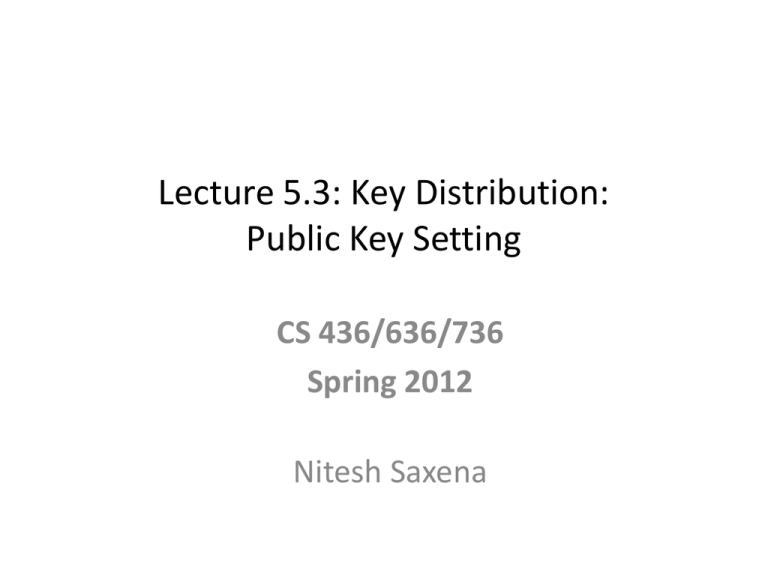lecture5.3
advertisement

Lecture 5.3: Key Distribution: Public Key Setting CS 436/636/736 Spring 2012 Nitesh Saxena Course Administration • HW2 due – Tuesday, 11am – Feb 28 2 Course Admin • Mid-Term Exam – On March 08 – In class, from 11am-12:15pm • Covers lectures up to Feb 23 • In-class review on Mar 06 (Tuesday) • Strictly closed-book (no cheat-sheets are allowed) • A sample exam will be provided as we near the exam date 3 Outline of Today’s lecture • Key Distribution • Public Key Setting • Certificates and Public Key Infrastructure 4 Key Distribution • Cryptographic primitives seen so far assume – In private key setting: Alice and Bob share a secret key which is unknown to Oscar. – In public key setting: Alice has a “trusted” (or authenticated) copy of Bob’s public key. • • • • • But how does this happen in the first place? Alice and Bob meet and exchange key(s) Not always practical or possible. We need key distribution, first and foremost! Idea: make use of a trusted third party (TTP) 5 Public Key Distribution • Public announcements (such as email) – Can be forged • Public directory – Can be tampered with • Public-key certification authority (CA) (such as verisign) – This is what we use in practice – CA issues certificates to the users 6 Naming and Certificates • Certification authority’s vouch for the identity of an entity - Distinguished Names (DN). /O=UAB/OU=CIS/CN=Nitesh Saxena – Although CN may be same, DN is different. • Policies of certification – Authentication policy What level of authentication is required to identify the principal. – Issuance policy Given the identity of principal will the CA issue a certificate? 7 Types of Certificates • CA’s vouch at some level the identity of the principal. • Example – Verisign: – Class 1 – Email address – Class 2 – Name and address verified through database. – Class 3- Background check. 8 Public Key Certificate • Public Key Certificate – Signed messages specifying a name (identity) and the corresponding public key. • Signed by whom – Certification Authority (CA), an organization that issues public key certificates. • We assume that everyone is in possession of a trusted copy of the CA’s public key. • CA could be – Internal CA. – Outsourced CA. – Trusted Third-Party CA. 9 Public Key Certificate Note: Mechanism of certification and content of certificate, will vary but at the minimum we have email verification and contains ID and Public Key. 10 Certificate Verification/Validation 11 Certificate Revocation • CA also needs some mechanism to revoke certificates – Private key compromised. – CA mistake in issuing certificate. – Particular service the certificate grants access to may no longer exist. – CA compromised. • Expiration time solves the problems only partially. • Certification Revocation Lists (CRL) – a list of every certificate that has been revoked but not expired. – CRL’s quickly grow large! • CRL’s distributed periodically. – What about time period between revocation and distribution of CRL? • Other mechanisms – OCSP (online certificate status protocol) 12 X.509 • Clearly, there is a need for standardization – X.509. • Originally 1988, revised 93 and 95. • X.509 is part of X.500 series that defines a directory service. • Defines a framework for authentication services by X.500 directory to its users. • Used in S/MIME, IPSEC, SSL etc. • Does not dictate use of specific algorithm (recommends RSA). 13 X.509 Certificate 14 Advantages of CA Over KDC • • • • CA does not need to be on-line all the time! CA can be very simple computing device. If CA crashes, life goes on (except CRL). Certificates can be stored in an insecure manner!! • Compromised CA cannot decrypt messages. • Scales well. 15 Internet Certificate Hierarchy Internet Policy Registration Authority Policy Certification Authorities Certification Authority Individuals/roles/orgs. 16 Types of certificates • Organizational Certificates Principal’s affiliation with an organization • Residential certificates Principal’s affiliation with an address • Persona Certificates Principal’s Identity • Principal need not be a person. It could be a role. 17 Public-key Infrastructure (PKI) • Combination of digital certificates, public-key cryptography, and certificate authorities. • A typical enterprise's PKI encompasses – – – – issuance of digital certificates to users and servers end-user enrollment software integration with corporate certificate directories tools for managing, renewing, and revoking certificates; and related services and support • Verisign, Thawte and Entrust – PKI providers. • Your own PKI using Mozilla/Microsoft certificate servers 18 Problems with PKI – Private Key • Where and how is private key stored? – Host – encrypted with pass phrase – Host – encrypted by OS or application – Smart Card • Assumes secure host or tamper proof smartcard. 19 Problems with PKI - Conflicts • X.509, and PGP remain silent on conflicts. • They assume CA’s will ensure that no conflicts arise. • But in practice conflicts may exist – – John A. Smith and John B. Smith may live at the same address. 20 Trustworthiness of Issuer • A certificate is the binding of an external identity to a cryptographic key and a distinguished name. If the issuer can be fooled, all who rely upon the certificate can be fooled • How do you trust CA from country XYZ (your favorite prejudice). 21 Further Reading • Kerberos RFC: RFC-1510 • X.509 page http://www.ietf.org/html.charters/pkixcharter.html • Ten Risks of PKI http://www.schneier.com/paper-pki.html 22 Some questions • Can a KDC learn communication between Alice and Bob, to whom it issued keys? • Can a CA learn communication between Alice and Bob, to whom it issued certificates? • What happens if the CA is online all the time? • Alice uses her private key, public key pairs and a CA issued certificate. She learnt that Eve might have leaned her key. What should she do? 23 Some Questions • Sometimes when you access an https website, you get a security warning. What is that warning for? • Sometimes when you connect to an SSH server, you get a security warning. What is that warning for? • What is a self-signed certificate? 24


